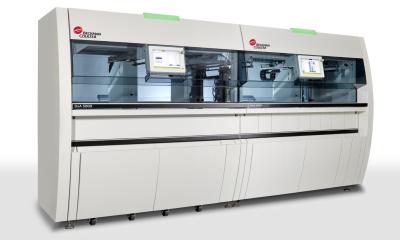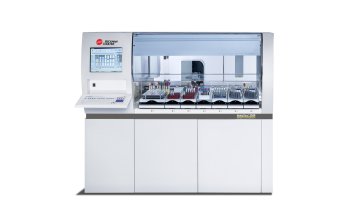
Image source: Beckman Coulter
Interview • Urinalysis for Covid-19 diagnostics
Automation to relieve pandemic pressure from laboratories
Since the start of the coronavirus pandemic, ways to reliably diagnose the infection are desperately needed – while medical labs worldwide ache under the immense caseload. To provide a solution, Beckman Coulter recently launched the DxU Iris, a urinalysis solution which aims to improve lab workflow by significantly reducing manual microscopy review to less than 3%. We spoke with Anna Dalmazzo, Beckman Coulter’s urinalysis expert for Europe, about the benefits of the device, lab automation in general and the necessity of keeping workflows simple.
Interview: Mareike Scholze
HiE: Which indications/diseases benefit most from the features of the new device?
Anna Dalmazzo: 'A urine analyser is a device used in the laboratory to perform urine testing. It's used to detect and manage a wide range of disorders, such as urinary tract infections, liver disease, glycosuria, haematuria, etc. The features of this system allow for the particles responsible for these diseases to be viewed directly on a screen, which means they can be highlighted and quantified.'
Could you elaborate on how the Covid-19 pandemic has increased pressure on laboratories? How can automation help alleviate the pressure?
'Diagnostic testing has been at the forefront of the world’s response to Covid-19. In 2020, clinical laboratory testing increased by 245%, resulting in highly strained resources. Laboratory staff are working at full speed now, more than ever. Since Covid-19, they’ve started taking on greater responsibility, working longer days, picking up extra shifts and in some cases even working across multiple labs to keep up.
Laboratory automation helps in several ways. First, it removes a lot of repetitive work required of lab professionals, increasing laboratory efficiency by providing consistent productivity and quality. Automation also enables the lab to reduce manual errors and improve standardisation, both within and between different labs in the same health network.
When it comes to urinalysis, a routine urinalysis test is one of the most commonly ordered tests by physicians, representing up to 30% of all samples received. Laboratory stress is further exacerbated by common manual review. Manual inspection interrupts workflow and can take up to 6 times as long per sample. Automating routine urinalysis workflows reduces sample subjectivity and variability, helping laboratories of all sizes standardise processes, drive faster turnaround times, and deliver high-quality results. Beckman Coulter’s new urinalysis solution reduces manual microscopy review to less than 3%1 and cuts sample processing time by up to 78%2.'
Research suggests that urinalysis can provide valuable information on Covid infections and severity prognosis. Can the new product contribute to improving Covid-specific diagnostics, and if so, how?
We can conclude that urinalysis is strongly recommended for all patients with Covid-19, whereby it may provide important information for clinical management and risk prediction
Anna Dalmazzo
'Several publications have described the clinical significance of urinalysis in predicting the severity of Covid-19. It is now undeniable that the managed care of patients with Covid-19 encompasses the identification of clinical and laboratory parameters, enabling the accurate risk stratification of patients progressing towards severe or critical infections.
The urinalysis results of retrospective studies showed proteinuria and haematuria in most patients. An analysis of urine sediment also revealed the presence of erythrocytes and casts in nearly half of all patients. Another important aspect that emerged from this retrospective investigation is that renal involvement may be a significant predictor of unfavourable disease progression.
We can therefore conclude that urinalysis is strongly recommended for all patients with Covid-19, whereby it may provide important information for clinical management and risk prediction.'
The new urinalysis solution is equipped with AI technology. How was the algorithm trained, and how reliable is it?
'The DxU Iris Workcell was developed using proprietary Digital Flow Morphology technology with Auto-Particle Recognition (APR) Software to enable laboratories to deliver standardised results using Artificial Intelligence.
The AI with Digital Flow Morphology and Auto-Particle Recognition auto-classifies 12 elements analysed through four specific features: size, shape, contrast, and texture.
The algorithm was trained with over 26,000 particle images making it highly reliable, as the approach to results is objective, not subjective.
The benefit of the DxU iRICELL is the easy identification of urine sediment, which accelerates the delivery of accurate patient results.'

Image source: Beckman Coulter
Additional features often result in more complicated handling. How does the new user interface affect the learning curve of the solution?
'DxU Iris solutions are designed for laboratories of all sizes and offer several benefits, which include:
- An intuitive user interface, allowing the operator to comfortably navigate, access key reference information, and simplify training across multiple Beckman Coulter instruments
- iWARE Integrated Urinalysis Software, which comes as standard on the analyser, providing onboard validation and result verification in a single step, which means operators can improve urinalysis testing efficiency and reduce the human resources required
- An optional Load and Unload station increases the capacity of racks for a total of 200 onboard samples to improve efficiency
The new user interface helps shorten the learning curve of the solution by aiding the operator in verifying the particles on the screen by comparing them with the Atlas loaded in the software, saving the images for further consultation with an expert if desired, or to create their own Atlas.'
References:
2 Beaufort Memorial Urinalysis Workflow Case Study, CS-52048.
22.03.2022











